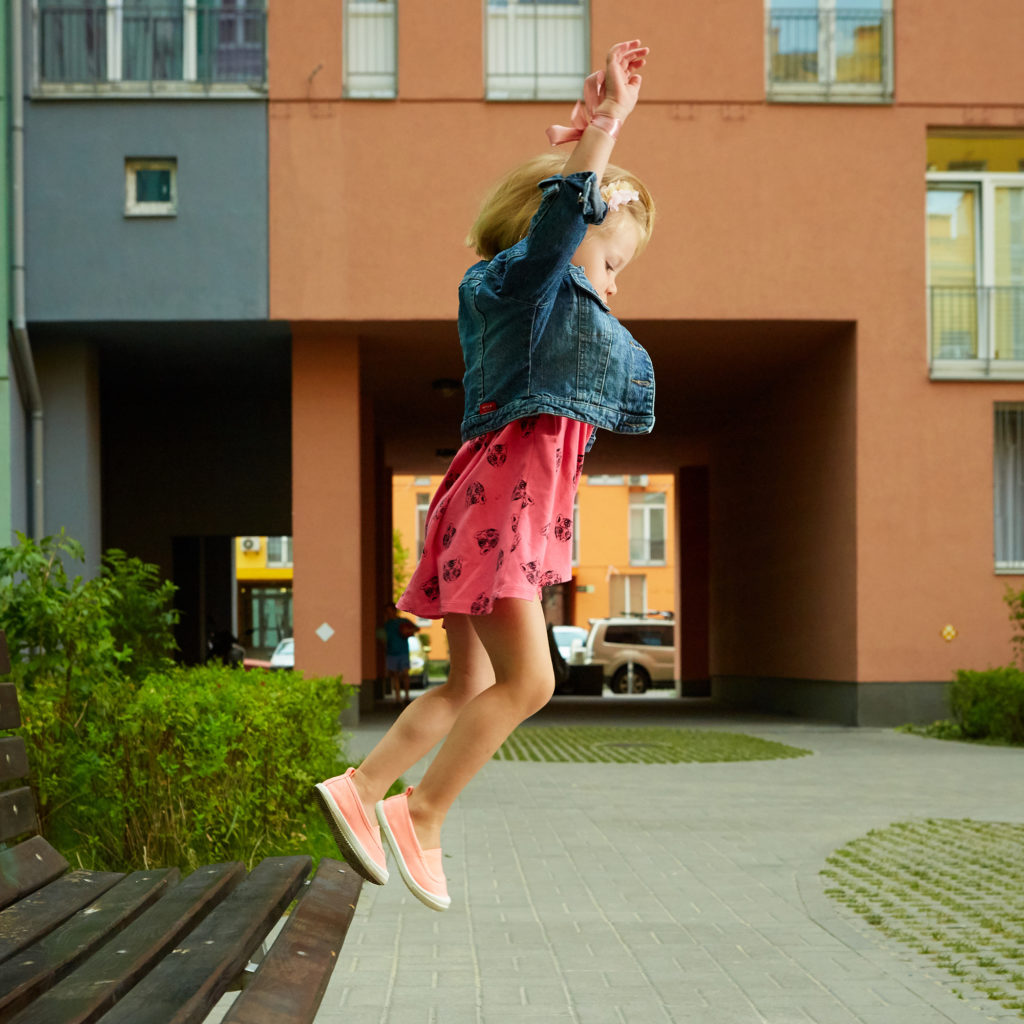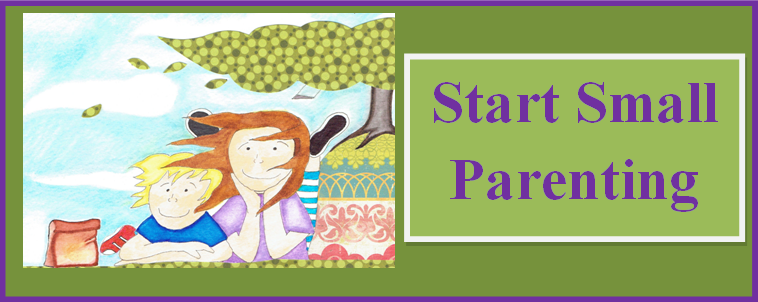
Young children live and learn through their bodies. Without the distraction of verbal language and with immature cognitive development, young children live and learn through their bodies. They grow and learn about the world through their developing senses: vision, taste, smell, auditory, tactile (touch), vestibular (sense of balance), and proprioception (body awareness).
We can help children to integrate what is received through these senses. Learning to have more awareness and be in control of one’s body is part of impulse control and leads to more choice. Specific movement experiences can help children with that sensory integration.
Sensing the World
Sensory processing is how we use information provided by all the sensations coming from within the body and from without in the external environment. We use this information to form a complete understanding of who we are, where we are, and what is happening around us.
Sensory integration is one of the most complicated aspects of child development. Sometimes, a child may have slower growth in one sensory area. This can manifest as difficulties with impulse control and self-regulation.
Learning to have more awareness and be in control of one’s body is part of being a respectful person. Respectful behaviors can be challenging for children who have less developed sensory awareness or integration. It can be very beneficial to give our children more opportunities and tools to increase their growth in this area.
Let’s look at three of the senses (tactile, vestibular, and proprioceptive) from our list above in relation to sensory awareness and integration.
Tactile (Touch)
This is the information we get and interpret through our skin receptors. Tactile stimulation of the nerves develops interconnections and neural pathways in the brain cells. Touch receptors are not only in our hands, but all over our bodies. This system helps us understand temperature and feel pain. There is a relationship between touch and the emotional centers of our brain. This system helps us discern between pleasant and unpleasant experiences of touch.
Some children have difficulty processing tactile information that they encounter. Simple touch experiences may be extremely unpleasant, like the touch of the waistband on their pants or the messy feel of finger paint. Others need the opposite, seeking out as much touch that they can find – looking for hugs, squeezing and rubbing their hands together, or sitting very close to others.
Fun with Tactile Processing
- Water Play. Any kind of water play makes for great tactile input. Try cups, sponges, foam rollers, syringes in the bath or in buckets. Swimming is great for tactile input. The tactile resistance of water is 600x the resistance of air. Whole body immersion as well as the experience of buoyancy makes this an excellent experience to increase tactile awareness.
- Touch-and-Feel Book. Make your own with different textures on each page. Use objects from inside and outside the house – leaves, tinfoil, fabric scraps, sandpaper, etc.
- Sensory Bins – Fill some large Tupperware containers with a variety of textures – sand, dried beans, pasta, water, cotton balls, pudding, clay, etc. Practice scooping, dumping, squishing, shaking, pouring. Try immersing feet or elbows. Encourage using words to describe how the texture feels.
- Burrito Roll-Up – Have your child cross her arms over her chest or next to her body. Roll her tightly inside a blanket. Then, give massaging squishes to increase tactile (and whole body) awareness.
- Pillow Sandwich – Have your child lie between two large pillows or beanbags and provide him with pressing and squishing touch. Ask for feedback – would your child like soft, medium or hard squishes?
- Play dough hunt – Hide objects like coins, marbles, or small toys inside play dough or homemade dough. Your child will work on hand strength and tactile input in this activity.
- Building Tolerance – practice wearing offensive clothing (socks, jeans, any waistband, etc.) for small increments of time and gradually build up the length of time. A visual or auditory timer can be set to help identify when the time will be up.
- Big Bear, Little Bear – (which is great for all three of the sensory processes we are working with): In this delightful game, parents’ touch gives feedback to the child’s body through strong, appropriate pressure. The parent is Big Bear and the child is Little Bear. Big Bear says, “Oh, Little Bear, why can’t you sleep? I’ll help.” Big Bear scoops the child onto her lap and holds him tightly. As the parent begins to “fall asleep”, her grip loosens slightly and the child starts to climb down. The parent’s hold is tight enough for the child to struggle and get strong tactile sensation. Big Bear notices, waking slightly, and grabs the child more tightly. Back to gruffling and snoring for the parent as the child tries to slowly escape again without waking Big Bear. Each time, Big Bear lets Little Bear get a little further away. One time, Big Bear sleeps more soundly and the child actually hides nearby. Big Bear wakes up, sees the child is gone, and finds him. Then the game begins again. In addition to tactile feedback, there is shared control of child and parent, increased safety for the child, body map awareness, balance/imbalance, and, of course, the benefit of play.
Vestibular (Sense of Balance)
Centered in the inner ear, this system has to do with movement and balance. When we move our heads, fluids and organs in our ear shift as well. As the fluids move within semicircular canals, they inform us of changes in our head position, gravity, and direction and speed of movement. This gives us information about our spatial awareness – or where our bodies are in space – so we can make adjustments to maintain balance, muscle tone, and coordination. This helps us move efficiently and interact with our surroundings. This system also helps with stop and start movements as well as gross motor actions like climbing, swinging, jumping – and confidently knowing our body will help keep us from falling or getting hurt.
If there is compromise in this system, a child might need to move constantly to feel satisfied. Or he may have the opposite experience, fearful of movement because he feels imbalanced or insecure. This is the child who easily bumps into things, slouches, is uncoordinated, or looks as if he is uncomfortable in his body.
Fun with Vestibular Processing
- Go the park – The playground is filled with vestibular-promoting activities. Swings encourage directional movement and a constant shift of the inner ear. Slides provide a change in speed and levels. Hanging upside down is excellent as is jumping from platforms or object to object. If your park has monkey bars (our town sadly took them out), then encourage climbing across them or hanging upside down.
- Blanket Swing – Two adults swing the child in a blanket or sheet. This encourages the vestibular system, plays within the realm of safety, and is fun!
- Swivel Chair Spin – Spinning in an office-style swivel chair. More fun!
- Obstacle Course – Running, climbing, going through, up/down, over/under, balance beam (or curb walk), bouncing on an exercise ball, jump rope, cone slalom – all are wonderful ways to stimulate the vestibular system.
- Games – Flashlight tag, Twister, catching a ball, Kids Yoga, and Big Bear, Little Bear (described in the previous section) are helpful.
Proprioception (Body awareness)
Sensory and motor nerves send and receive impulses to and from the central nervous system. Joints and muscles send messages to the brain to help coordinate movement. This is proprioception, or the sense we have of our bodies. It’s knowing where our “bubble space” – or how far we can reach with all our body parts – starts and ends. While the vestibular system tells the brain about balance and moving against gravity, the proprioceptive system helps the coordination and movement of arms and legs in an efficient manner. It’s the ability to know where a body part is without even having to look at it.
This system helps us to discern how much force to use or the direction of our movements. A child uses proprioception to learn how much effort it takes to lift a box or how much force to use when writing so the tip of the pencil doesn’t break. It allows children to explore movement in a coordinated way – and how to play without being too rough.
Sometimes issues with proprioception will be seen in a child who pushes other kids or throws the ball too hard. It’s difficult for them to control the force they use. In other children, one might see the opposite – a child who appears tired or sluggish or moves slowly through the simplest motor tasks.
Both types of children can benefit from proprioceptive activities like moving against resistance with a push or pull.
Fun with the Proprioceptive System
- Push the Wall – In a deep lunge, use both arms to push against a wall. The parent can say, “This room is too small! Let’s push the wall and make it bigger.” Have the child lean with all her might into the wall, pushing hard three times, for 5-10 seconds each time. Move to each wall, and push three times. You can also say, “Now the ceiling’s too low!” Stomp on the floor to push it down. You can lie on your backs and pretend to push the ceiling away, too. Deep joint pressure of this activity nourishes the proprioceptive system and has a calming effect. Pressing different body parts strengthens body awareness. This move also helps organize a child’s sensory system. It’s calming for high energy kids and activating for those with low energy.
- Wheelbarrow Walk – A parent or friends holds the child’s feet while he acts as a “wheelbarrow” – walking on hands. Put a bucket of beanbags at one end of the play space and an empty bucket at the other end. The foot holder places a beanbag on the child’s back. Then together they wheelbarrow walk to place it the other bucket. If doing it with kids, the partners can switch positions. An alternative is to have the child use a real wheelbarrow to transport the beanbags or other objects like rocks or leaves.
- Trampoline – Best invention for the proprioceptive system ever!
- Wagon Pull – Have the child pull a wagon with your pet in it, another child, or items of varying weights.
- Tug of War – Grab an old bed sheet and get people on either end to pull against one another.
- Roll it Out – One rolling pin and dough, clay, or playdoh. Roll away…
- Water Babies – Help infants develop a healthy relationship with water in the bath and the pool. Water exploration increases interconnections of neural pathways in brain cells. I highly recommend baby water classes. They are ready to start parent child Water Babies classes when they can hold up their head on their own. Not only is this a great proprioceptive activity, but it encourages the parent/child bond through face-to-face and skin-to-skin contact in a pleasurable environment.
- Bubble Space – This is the space around the child, described by a circle an arms’ distance from the body. A rope or hula hoop can be used on the floor to help visualize the boundaries of one’s personal bubble. When playing with others, encourage your child to practice staying in their bubble space – and no popping another’s bubble. This helps with awareness of oneself and others when moving through space. It also prohibits unwanted touch (poking, hitting, etc.) through practice.
- Big Bear, Little Bear (described in the first section) is very helpful for the child’s development of body awareness and their body map.
Brain Gym
Brain Gym is a remarkable movement-based learning program that has helped people of all ages turn their learning challenges into successes. “Learning through movement” was developed by educator and reading specialist Paul E. Dennison and his wife and colleague, Gail E. Dennison. It is an educational philosophy which consists of a specific set of movements and processes. The guiding principle is that moving with intention leads to optimal learning.
There are 26 original Brain Gym movements which recall movements naturally done during the first years of life when learning to coordinate the eyes, ears, hands, and whole body. They often bring about dramatic improvements in areas such as concentration, focus, memory, physical coordination, organization, attitude, and self-responsibility.
I highly recommend this small, easy-to-use pamphlet as a great place to start:
Brain Gym: Simple Activities for Whole Brain Learning, by Paul E. Dennison (Author), Gail E. Dennison (Author, Illustrator).
If you would like to know more about this system, visit. http://www.braingym.org/
Guidelines for Working with Your Child
When working with your child on sensory integration, but sure to follow these guidelines:
- Watch for Overwhelm – While exposure to a variety of sensory experiences supports kids in healthy development, keep it simple. Especially at first. Introduce sensory play gradually, one sensation at a time, so as not to overwhelm. Watch your child’s responses and behavior. If she is enjoying herself, build on that and expose her to more.
- Child-led – Allow the child to approach the activity himself. Let him watch first and adapt the activity to meet his needs.
- Benefits Vary – Children will respond in their own ways and the benefits will be unique to them.
- How Does Your Child Learn? – Observe your child during his everyday routine. Notice what he reacts to and in what ways. Build sensory activities to meet his needs.
- If a child has agitations or is overwhelmed by typical sensory experiences, please check with a local occupational therapist or movement therapist as to what activities will work best for your child.

